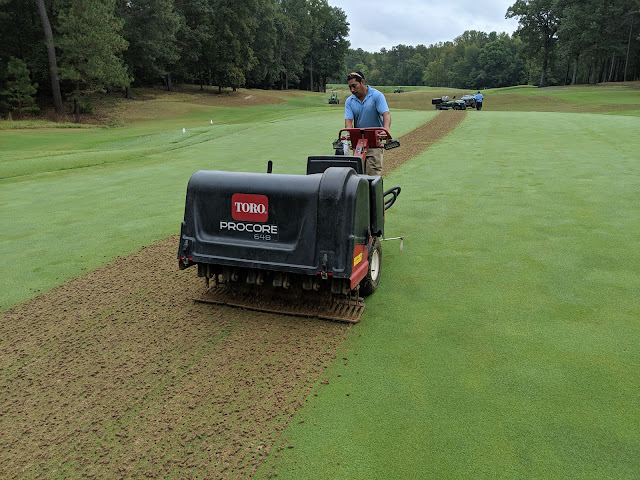While Manakin flourishes in the heat, time to work on the Sabot
With everyone enjoying their time on the Manakin we are making the most out of the that distraction to get a few things done on the Sabot. All of the greens were core aerated on Monday with 3/8" tines.
Core aeration pulls out accumulated organic matter in the upper layer of the greens. The darker black areas in the profile are what we are aiming for. On both courses too much organic matter has been allowed to build up over the past few years. This is why the greens can't firm up and root growth is limited. As we dilute the organic matter with sand and introduce more air to the profile, the greens will become firmer and most importantly, healthier, providing a more consistent surface.
50 tons of sand was brushed into the aeration holes early in the week.
There is never a great time to aerate bentgrass greens but having another course for members to go enjoy during the process sure is nice.
We began mowing the greens dry on Thursday. We will mow them again on Friday afternoon and then let them continue to grow in over the weekend. The dew in the mornings makes the remaining sand sticky, so the mowers would just make a mess if we went out first thing like normal. We will drag the dew off with a rope for the weekend and then hopefully be able to start mowing them wet come Monday.
We also got moving on the bluegrass overseeding process on the Sabot fairways. We learned some from our process on the tees and went a little more aggressive on the fairways. A higher rate of growth regulator was applied to the fairways to basically stop bermudagrass growth for the season. The verticutters thinned out the canopy nicely.
After the verticutter debris was cleaned up, the fairways were mowed down to .325". We have to balance how aggressive the prep is going into the winter. The more aggressive, the better the seed catch but it also puts more winter injury in play.
Ben sat on the dimple seeder for 3 days and put about 2 tons of seed into the fairways. Again the application cost for the bluegrass ends up very similar to ryegrass since the seeding rates are different. We are seeding the bluegrass in at 3 lbs per 1000 square feet vs the rye where you want close to 8 lbs. The fairways are being watered well at night and thanks to the upcoming change in weather, we are hoping that having to run the sprinklers in the afternoons will be not be an issue. We will continue to monitor firmness but our goal is to keep any cart restrictions to a minimum.
It is hard to tell on some of the tees but the bluegrass is making its way through the bermuda. The goal here with the bluegrass is that it can coexist with the bermuda year after year without much more additional overseeding. The newer bluegrass biotypes can survive the summer and yield to very little disease. Once the bermuda goes dormant this initial application of bluegrass will continue to fill in until Christmas and then really step on the gas in early spring. This process will not be quick like the rye has been, but patience this winter will be rewarded in the spring and hopefully, for many years to come.
Making progress!








